NRSG353 Case Study: Comprehensive Analysis of Congestive Heart Failure
VerifiedAdded on 2023/04/24
|16
|2639
|57
Case Study
AI Summary
This case study provides a detailed analysis of congestive heart failure (CHF), including its causes, incidence, risk factors, and impact on patients and their families. It explores common symptoms like shortness of breath, swollen ankles, and dizziness, explaining the underlying pathophysiology of each. The study also discusses the pharmacodynamics and pharmacokinetics of warfarin, a common anticoagulant used in CHF treatment, and includes a nursing care plan focusing on oxygen therapy and symptom management. The case study uses a question/answer format and is supported by relevant citations, offering a comprehensive understanding of CHF management.
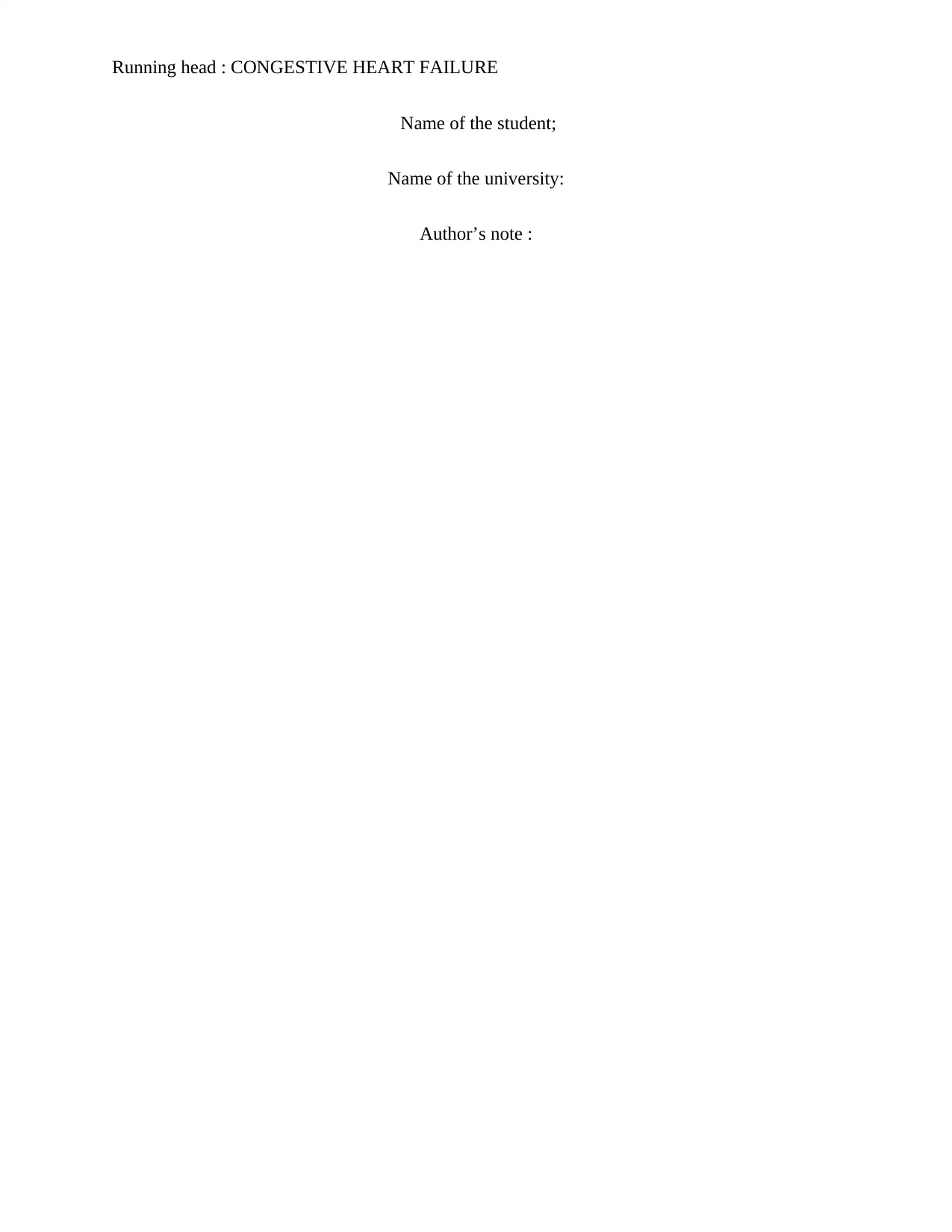
Running head : CONGESTIVE HEART FAILURE
Name of the student;
Name of the university:
Author’s note :
Name of the student;
Name of the university:
Author’s note :
Paraphrase This Document
Need a fresh take? Get an instant paraphrase of this document with our AI Paraphraser
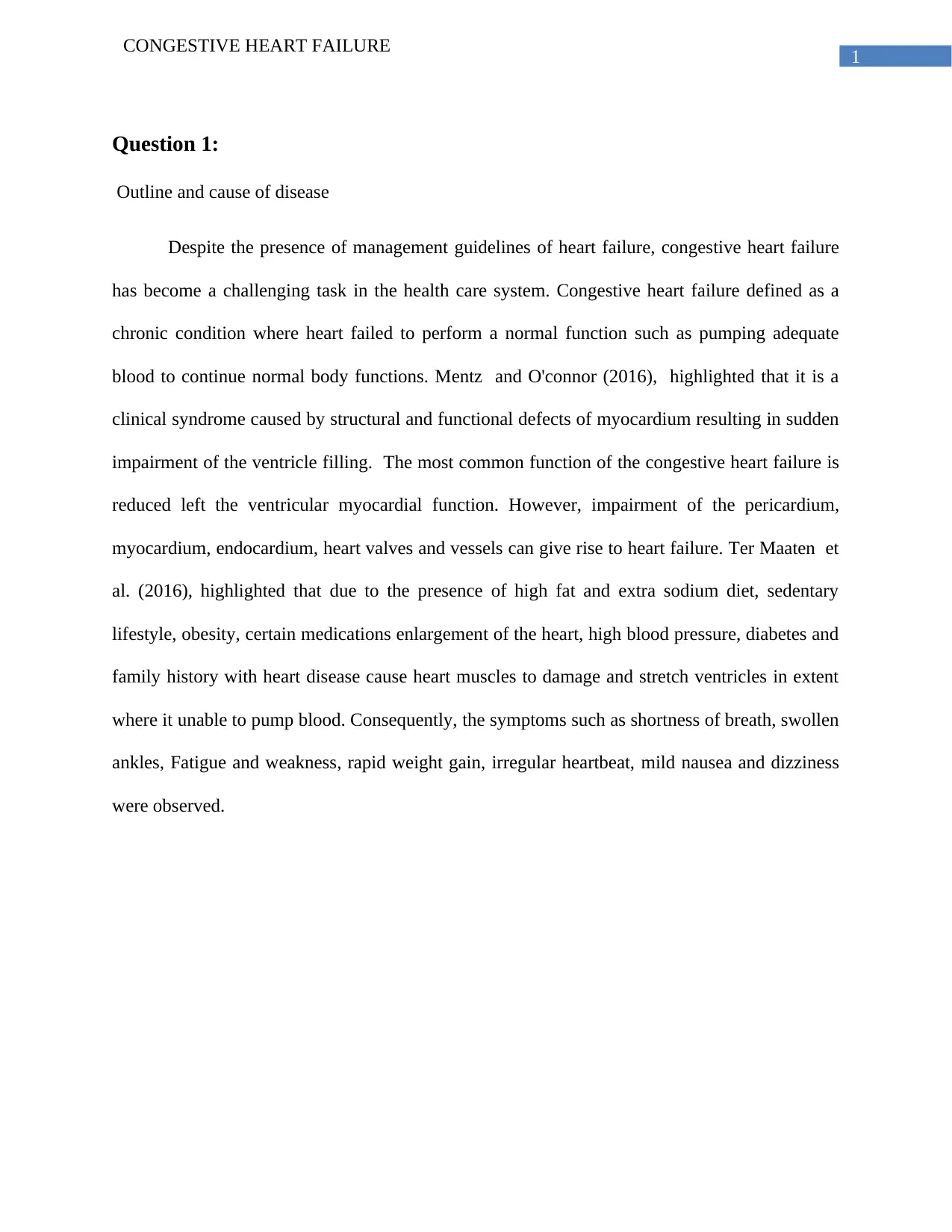
1
CONGESTIVE HEART FAILURE
Question 1:
Outline and cause of disease
Despite the presence of management guidelines of heart failure, congestive heart failure
has become a challenging task in the health care system. Congestive heart failure defined as a
chronic condition where heart failed to perform a normal function such as pumping adequate
blood to continue normal body functions. Mentz and O'connor (2016), highlighted that it is a
clinical syndrome caused by structural and functional defects of myocardium resulting in sudden
impairment of the ventricle filling. The most common function of the congestive heart failure is
reduced left the ventricular myocardial function. However, impairment of the pericardium,
myocardium, endocardium, heart valves and vessels can give rise to heart failure. Ter Maaten et
al. (2016), highlighted that due to the presence of high fat and extra sodium diet, sedentary
lifestyle, obesity, certain medications enlargement of the heart, high blood pressure, diabetes and
family history with heart disease cause heart muscles to damage and stretch ventricles in extent
where it unable to pump blood. Consequently, the symptoms such as shortness of breath, swollen
ankles, Fatigue and weakness, rapid weight gain, irregular heartbeat, mild nausea and dizziness
were observed.
CONGESTIVE HEART FAILURE
Question 1:
Outline and cause of disease
Despite the presence of management guidelines of heart failure, congestive heart failure
has become a challenging task in the health care system. Congestive heart failure defined as a
chronic condition where heart failed to perform a normal function such as pumping adequate
blood to continue normal body functions. Mentz and O'connor (2016), highlighted that it is a
clinical syndrome caused by structural and functional defects of myocardium resulting in sudden
impairment of the ventricle filling. The most common function of the congestive heart failure is
reduced left the ventricular myocardial function. However, impairment of the pericardium,
myocardium, endocardium, heart valves and vessels can give rise to heart failure. Ter Maaten et
al. (2016), highlighted that due to the presence of high fat and extra sodium diet, sedentary
lifestyle, obesity, certain medications enlargement of the heart, high blood pressure, diabetes and
family history with heart disease cause heart muscles to damage and stretch ventricles in extent
where it unable to pump blood. Consequently, the symptoms such as shortness of breath, swollen
ankles, Fatigue and weakness, rapid weight gain, irregular heartbeat, mild nausea and dizziness
were observed.
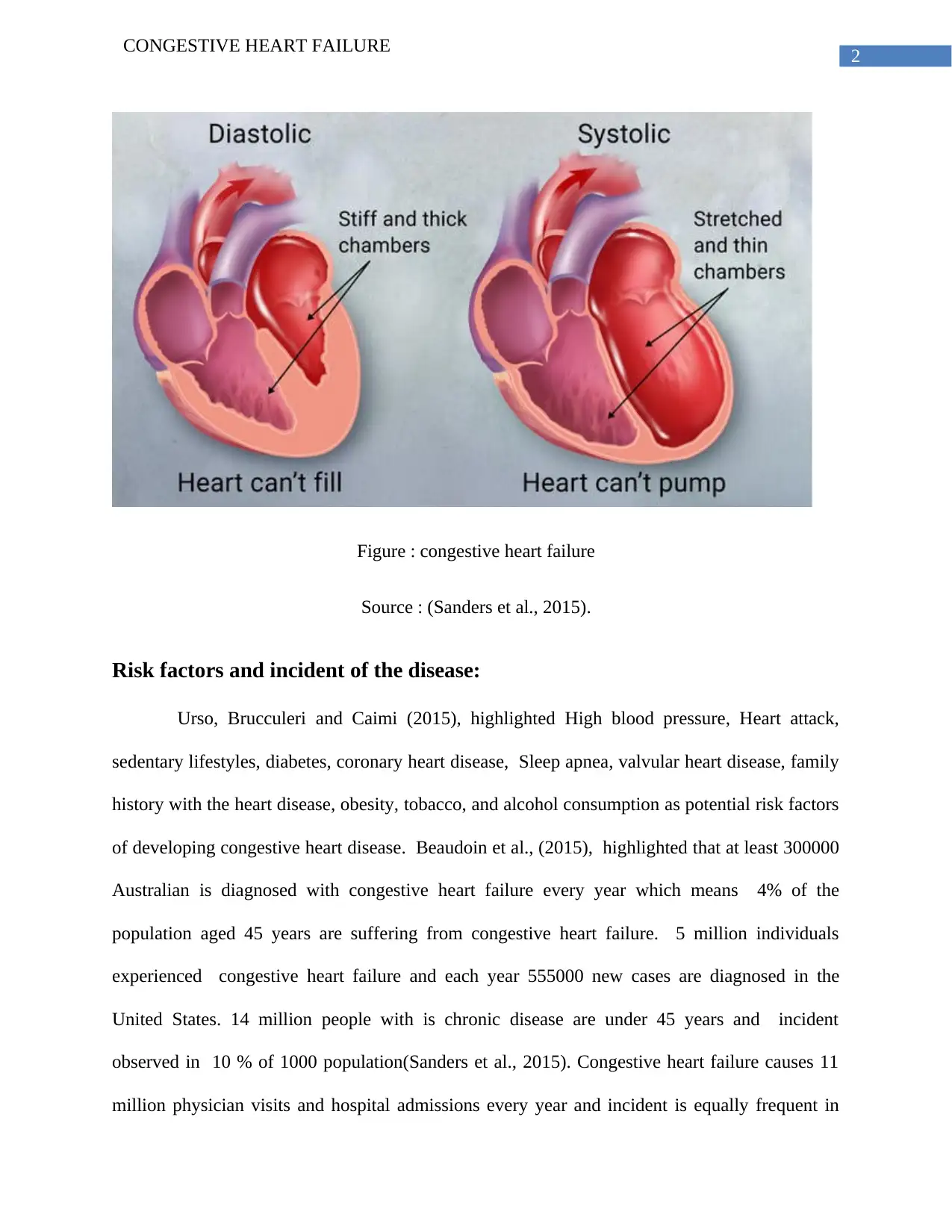
2
CONGESTIVE HEART FAILURE
Figure : congestive heart failure
Source : (Sanders et al., 2015).
Risk factors and incident of the disease:
Urso, Brucculeri and Caimi (2015), highlighted High blood pressure, Heart attack,
sedentary lifestyles, diabetes, coronary heart disease, Sleep apnea, valvular heart disease, family
history with the heart disease, obesity, tobacco, and alcohol consumption as potential risk factors
of developing congestive heart disease. Beaudoin et al., (2015), highlighted that at least 300000
Australian is diagnosed with congestive heart failure every year which means 4% of the
population aged 45 years are suffering from congestive heart failure. 5 million individuals
experienced congestive heart failure and each year 555000 new cases are diagnosed in the
United States. 14 million people with is chronic disease are under 45 years and incident
observed in 10 % of 1000 population(Sanders et al., 2015). Congestive heart failure causes 11
million physician visits and hospital admissions every year and incident is equally frequent in
CONGESTIVE HEART FAILURE
Figure : congestive heart failure
Source : (Sanders et al., 2015).
Risk factors and incident of the disease:
Urso, Brucculeri and Caimi (2015), highlighted High blood pressure, Heart attack,
sedentary lifestyles, diabetes, coronary heart disease, Sleep apnea, valvular heart disease, family
history with the heart disease, obesity, tobacco, and alcohol consumption as potential risk factors
of developing congestive heart disease. Beaudoin et al., (2015), highlighted that at least 300000
Australian is diagnosed with congestive heart failure every year which means 4% of the
population aged 45 years are suffering from congestive heart failure. 5 million individuals
experienced congestive heart failure and each year 555000 new cases are diagnosed in the
United States. 14 million people with is chronic disease are under 45 years and incident
observed in 10 % of 1000 population(Sanders et al., 2015). Congestive heart failure causes 11
million physician visits and hospital admissions every year and incident is equally frequent in
⊘ This is a preview!⊘
Do you want full access?
Subscribe today to unlock all pages.

Trusted by 1+ million students worldwide
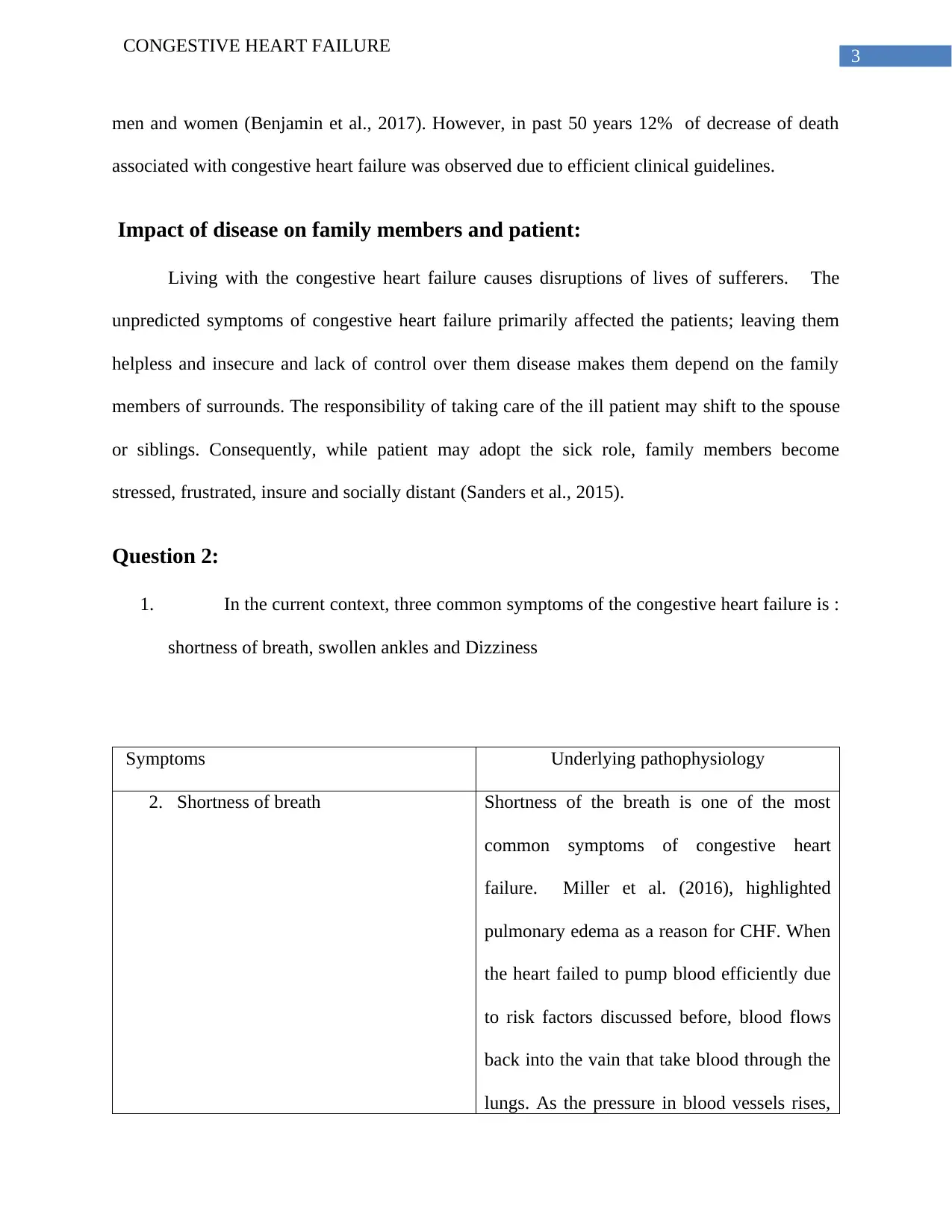
3
CONGESTIVE HEART FAILURE
men and women (Benjamin et al., 2017). However, in past 50 years 12% of decrease of death
associated with congestive heart failure was observed due to efficient clinical guidelines.
Impact of disease on family members and patient:
Living with the congestive heart failure causes disruptions of lives of sufferers. The
unpredicted symptoms of congestive heart failure primarily affected the patients; leaving them
helpless and insecure and lack of control over them disease makes them depend on the family
members of surrounds. The responsibility of taking care of the ill patient may shift to the spouse
or siblings. Consequently, while patient may adopt the sick role, family members become
stressed, frustrated, insure and socially distant (Sanders et al., 2015).
Question 2:
1. In the current context, three common symptoms of the congestive heart failure is :
shortness of breath, swollen ankles and Dizziness
Symptoms Underlying pathophysiology
2. Shortness of breath Shortness of the breath is one of the most
common symptoms of congestive heart
failure. Miller et al. (2016), highlighted
pulmonary edema as a reason for CHF. When
the heart failed to pump blood efficiently due
to risk factors discussed before, blood flows
back into the vain that take blood through the
lungs. As the pressure in blood vessels rises,
CONGESTIVE HEART FAILURE
men and women (Benjamin et al., 2017). However, in past 50 years 12% of decrease of death
associated with congestive heart failure was observed due to efficient clinical guidelines.
Impact of disease on family members and patient:
Living with the congestive heart failure causes disruptions of lives of sufferers. The
unpredicted symptoms of congestive heart failure primarily affected the patients; leaving them
helpless and insecure and lack of control over them disease makes them depend on the family
members of surrounds. The responsibility of taking care of the ill patient may shift to the spouse
or siblings. Consequently, while patient may adopt the sick role, family members become
stressed, frustrated, insure and socially distant (Sanders et al., 2015).
Question 2:
1. In the current context, three common symptoms of the congestive heart failure is :
shortness of breath, swollen ankles and Dizziness
Symptoms Underlying pathophysiology
2. Shortness of breath Shortness of the breath is one of the most
common symptoms of congestive heart
failure. Miller et al. (2016), highlighted
pulmonary edema as a reason for CHF. When
the heart failed to pump blood efficiently due
to risk factors discussed before, blood flows
back into the vain that take blood through the
lungs. As the pressure in blood vessels rises,
Paraphrase This Document
Need a fresh take? Get an instant paraphrase of this document with our AI Paraphraser
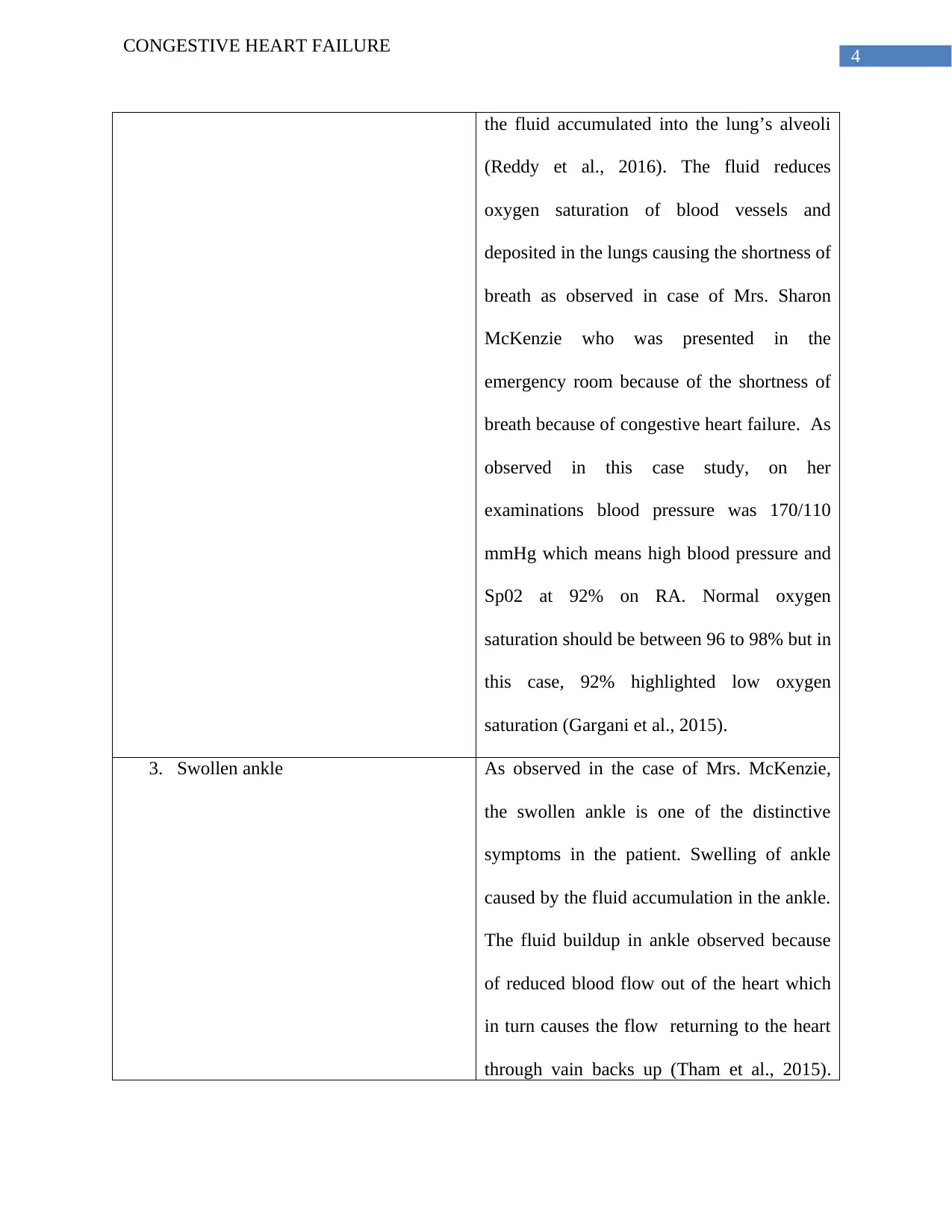
4
CONGESTIVE HEART FAILURE
the fluid accumulated into the lung’s alveoli
(Reddy et al., 2016). The fluid reduces
oxygen saturation of blood vessels and
deposited in the lungs causing the shortness of
breath as observed in case of Mrs. Sharon
McKenzie who was presented in the
emergency room because of the shortness of
breath because of congestive heart failure. As
observed in this case study, on her
examinations blood pressure was 170/110
mmHg which means high blood pressure and
Sp02 at 92% on RA. Normal oxygen
saturation should be between 96 to 98% but in
this case, 92% highlighted low oxygen
saturation (Gargani et al., 2015).
3. Swollen ankle As observed in the case of Mrs. McKenzie,
the swollen ankle is one of the distinctive
symptoms in the patient. Swelling of ankle
caused by the fluid accumulation in the ankle.
The fluid buildup in ankle observed because
of reduced blood flow out of the heart which
in turn causes the flow returning to the heart
through vain backs up (Tham et al., 2015).
CONGESTIVE HEART FAILURE
the fluid accumulated into the lung’s alveoli
(Reddy et al., 2016). The fluid reduces
oxygen saturation of blood vessels and
deposited in the lungs causing the shortness of
breath as observed in case of Mrs. Sharon
McKenzie who was presented in the
emergency room because of the shortness of
breath because of congestive heart failure. As
observed in this case study, on her
examinations blood pressure was 170/110
mmHg which means high blood pressure and
Sp02 at 92% on RA. Normal oxygen
saturation should be between 96 to 98% but in
this case, 92% highlighted low oxygen
saturation (Gargani et al., 2015).
3. Swollen ankle As observed in the case of Mrs. McKenzie,
the swollen ankle is one of the distinctive
symptoms in the patient. Swelling of ankle
caused by the fluid accumulation in the ankle.
The fluid buildup in ankle observed because
of reduced blood flow out of the heart which
in turn causes the flow returning to the heart
through vain backs up (Tham et al., 2015).
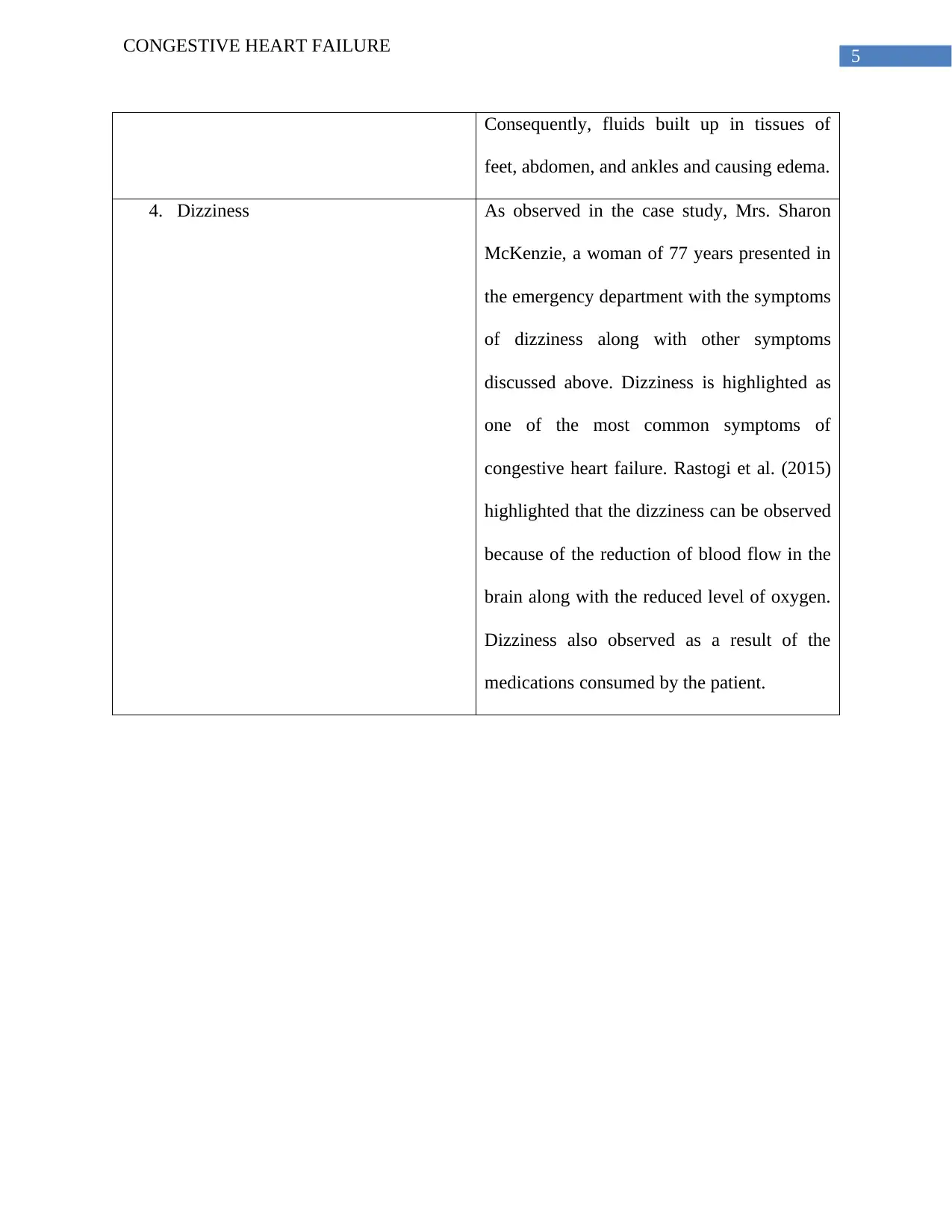
5
CONGESTIVE HEART FAILURE
Consequently, fluids built up in tissues of
feet, abdomen, and ankles and causing edema.
4. Dizziness As observed in the case study, Mrs. Sharon
McKenzie, a woman of 77 years presented in
the emergency department with the symptoms
of dizziness along with other symptoms
discussed above. Dizziness is highlighted as
one of the most common symptoms of
congestive heart failure. Rastogi et al. (2015)
highlighted that the dizziness can be observed
because of the reduction of blood flow in the
brain along with the reduced level of oxygen.
Dizziness also observed as a result of the
medications consumed by the patient.
CONGESTIVE HEART FAILURE
Consequently, fluids built up in tissues of
feet, abdomen, and ankles and causing edema.
4. Dizziness As observed in the case study, Mrs. Sharon
McKenzie, a woman of 77 years presented in
the emergency department with the symptoms
of dizziness along with other symptoms
discussed above. Dizziness is highlighted as
one of the most common symptoms of
congestive heart failure. Rastogi et al. (2015)
highlighted that the dizziness can be observed
because of the reduction of blood flow in the
brain along with the reduced level of oxygen.
Dizziness also observed as a result of the
medications consumed by the patient.
⊘ This is a preview!⊘
Do you want full access?
Subscribe today to unlock all pages.

Trusted by 1+ million students worldwide
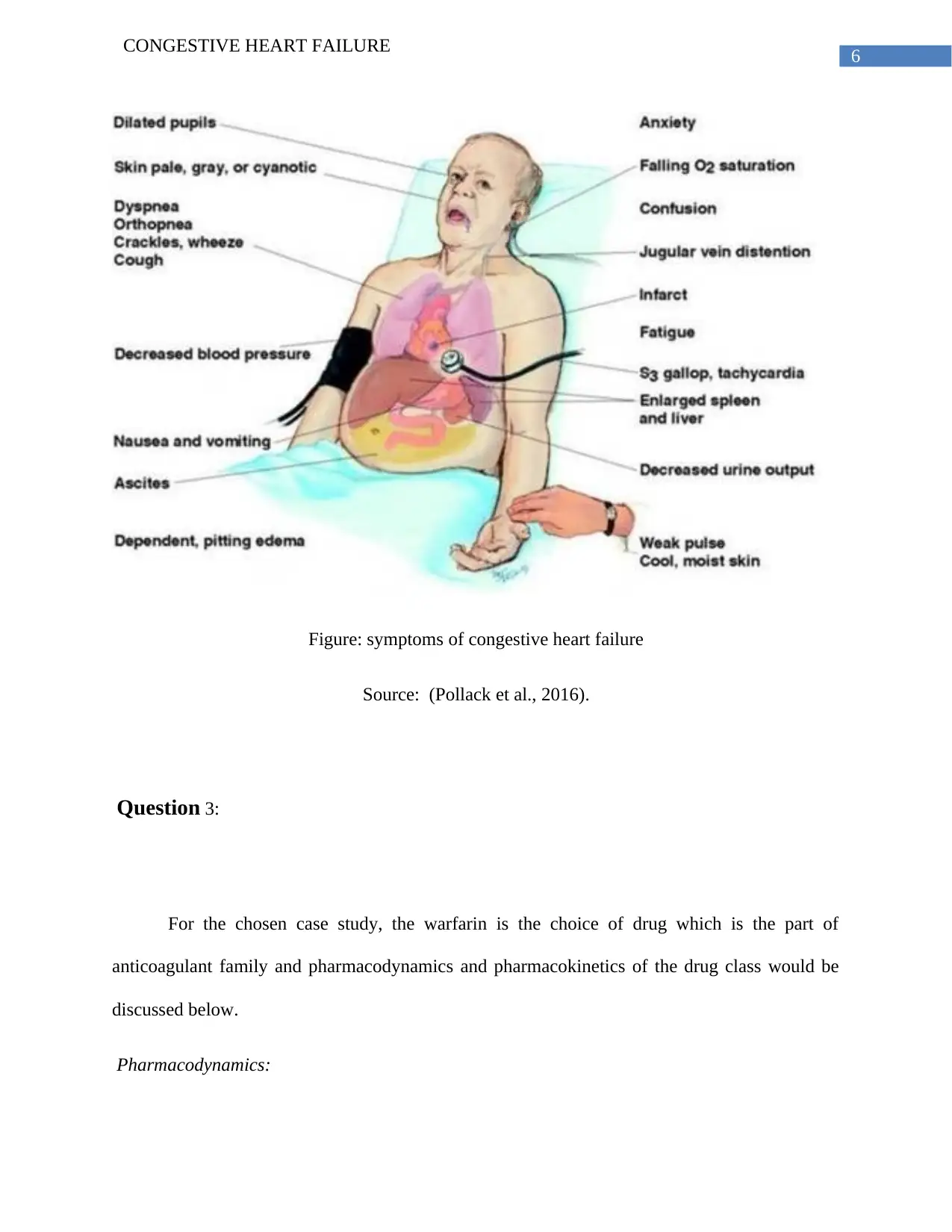
6
CONGESTIVE HEART FAILURE
Figure: symptoms of congestive heart failure
Source: (Pollack et al., 2016).
Question 3:
For the chosen case study, the warfarin is the choice of drug which is the part of
anticoagulant family and pharmacodynamics and pharmacokinetics of the drug class would be
discussed below.
Pharmacodynamics:
CONGESTIVE HEART FAILURE
Figure: symptoms of congestive heart failure
Source: (Pollack et al., 2016).
Question 3:
For the chosen case study, the warfarin is the choice of drug which is the part of
anticoagulant family and pharmacodynamics and pharmacokinetics of the drug class would be
discussed below.
Pharmacodynamics:
Paraphrase This Document
Need a fresh take? Get an instant paraphrase of this document with our AI Paraphraser
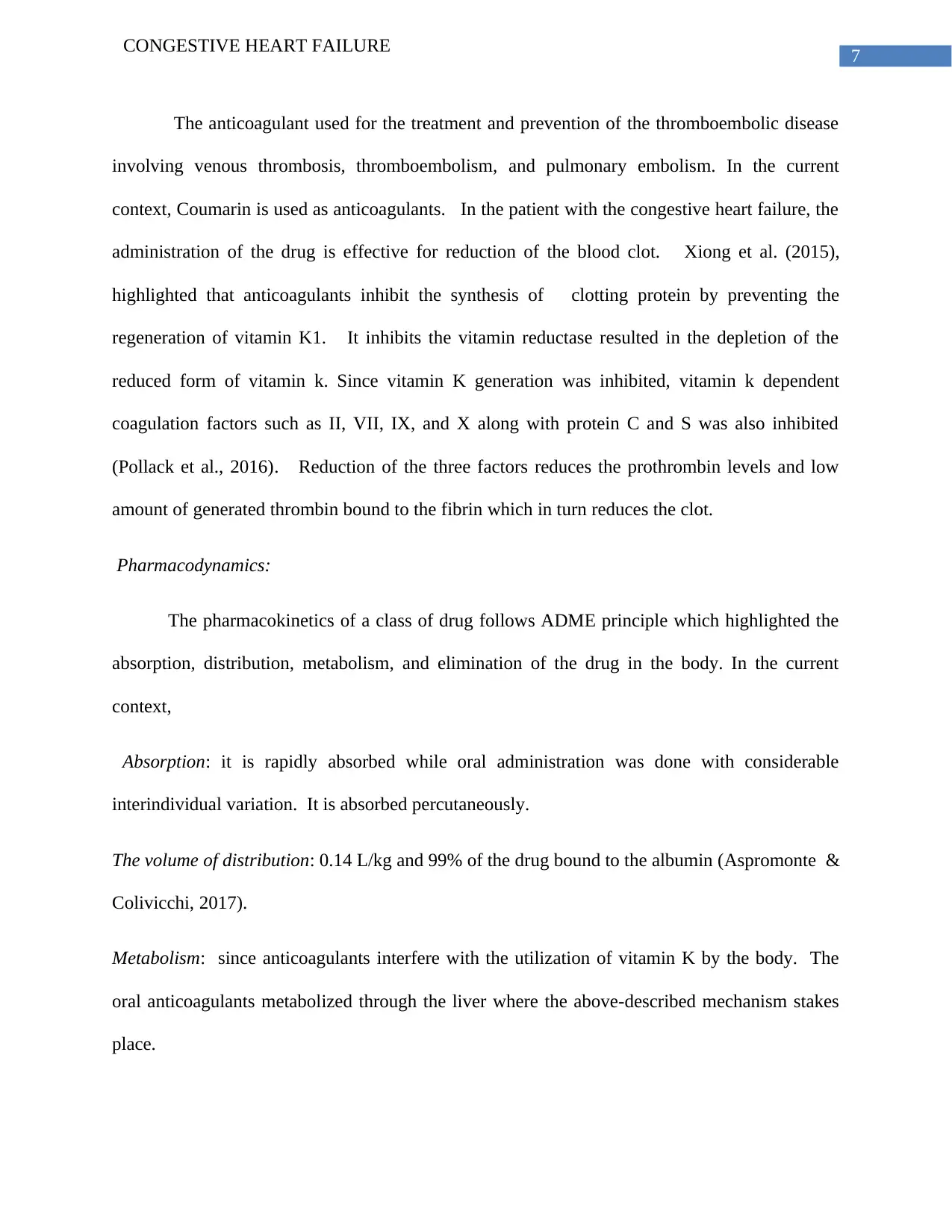
7
CONGESTIVE HEART FAILURE
The anticoagulant used for the treatment and prevention of the thromboembolic disease
involving venous thrombosis, thromboembolism, and pulmonary embolism. In the current
context, Coumarin is used as anticoagulants. In the patient with the congestive heart failure, the
administration of the drug is effective for reduction of the blood clot. Xiong et al. (2015),
highlighted that anticoagulants inhibit the synthesis of clotting protein by preventing the
regeneration of vitamin K1. It inhibits the vitamin reductase resulted in the depletion of the
reduced form of vitamin k. Since vitamin K generation was inhibited, vitamin k dependent
coagulation factors such as II, VII, IX, and X along with protein C and S was also inhibited
(Pollack et al., 2016). Reduction of the three factors reduces the prothrombin levels and low
amount of generated thrombin bound to the fibrin which in turn reduces the clot.
Pharmacodynamics:
The pharmacokinetics of a class of drug follows ADME principle which highlighted the
absorption, distribution, metabolism, and elimination of the drug in the body. In the current
context,
Absorption: it is rapidly absorbed while oral administration was done with considerable
interindividual variation. It is absorbed percutaneously.
The volume of distribution: 0.14 L/kg and 99% of the drug bound to the albumin (Aspromonte &
Colivicchi, 2017).
Metabolism: since anticoagulants interfere with the utilization of vitamin K by the body. The
oral anticoagulants metabolized through the liver where the above-described mechanism stakes
place.
CONGESTIVE HEART FAILURE
The anticoagulant used for the treatment and prevention of the thromboembolic disease
involving venous thrombosis, thromboembolism, and pulmonary embolism. In the current
context, Coumarin is used as anticoagulants. In the patient with the congestive heart failure, the
administration of the drug is effective for reduction of the blood clot. Xiong et al. (2015),
highlighted that anticoagulants inhibit the synthesis of clotting protein by preventing the
regeneration of vitamin K1. It inhibits the vitamin reductase resulted in the depletion of the
reduced form of vitamin k. Since vitamin K generation was inhibited, vitamin k dependent
coagulation factors such as II, VII, IX, and X along with protein C and S was also inhibited
(Pollack et al., 2016). Reduction of the three factors reduces the prothrombin levels and low
amount of generated thrombin bound to the fibrin which in turn reduces the clot.
Pharmacodynamics:
The pharmacokinetics of a class of drug follows ADME principle which highlighted the
absorption, distribution, metabolism, and elimination of the drug in the body. In the current
context,
Absorption: it is rapidly absorbed while oral administration was done with considerable
interindividual variation. It is absorbed percutaneously.
The volume of distribution: 0.14 L/kg and 99% of the drug bound to the albumin (Aspromonte &
Colivicchi, 2017).
Metabolism: since anticoagulants interfere with the utilization of vitamin K by the body. The
oral anticoagulants metabolized through the liver where the above-described mechanism stakes
place.
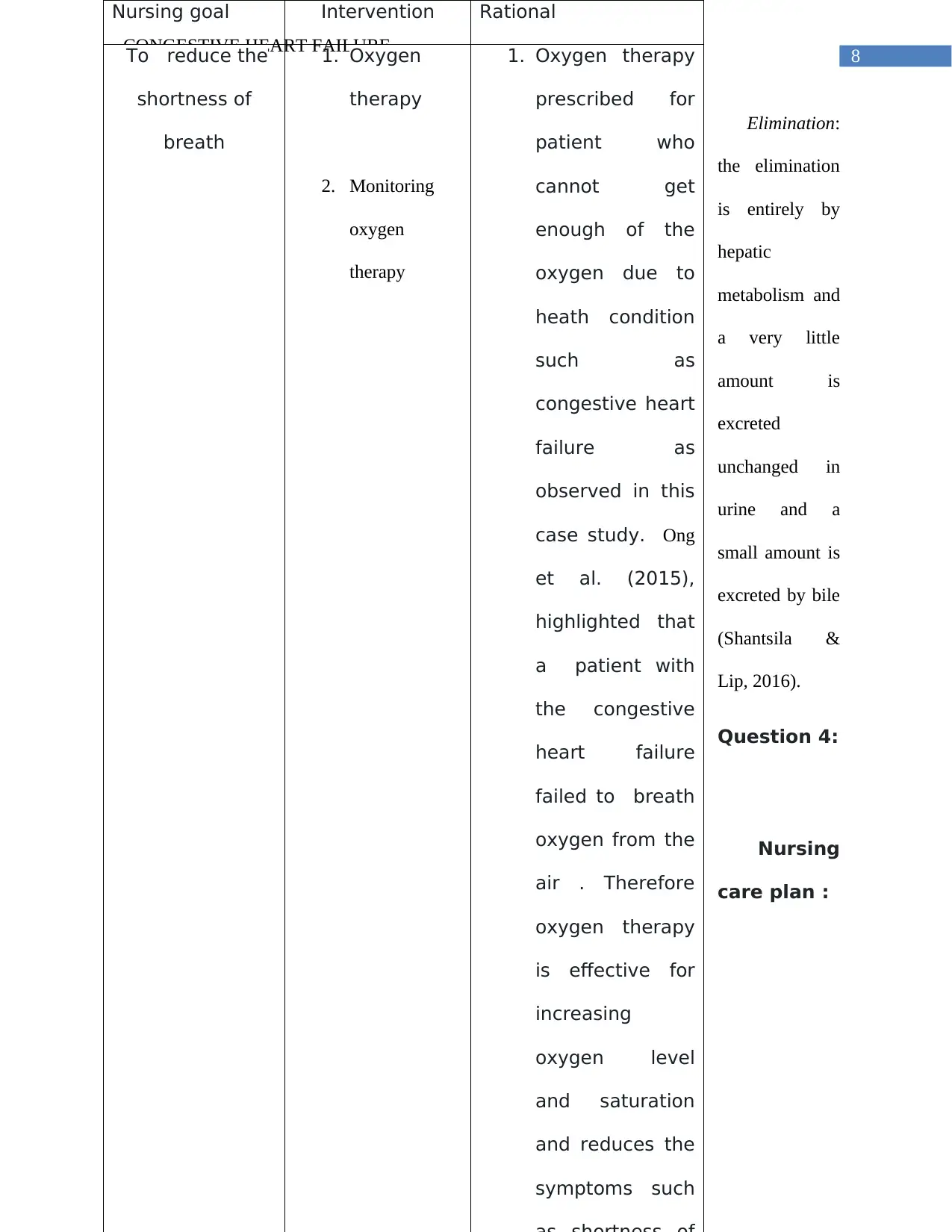
8
CONGESTIVE HEART FAILURE
Elimination:
the elimination
is entirely by
hepatic
metabolism and
a very little
amount is
excreted
unchanged in
urine and a
small amount is
excreted by bile
(Shantsila &
Lip, 2016).
Question 4:
Nursing
care plan :
Nursing goal Intervention Rational
To reduce the
shortness of
breath
1. Oxygen
therapy
2. Monitoring
oxygen
therapy
1. Oxygen therapy
prescribed for
patient who
cannot get
enough of the
oxygen due to
heath condition
such as
congestive heart
failure as
observed in this
case study. Ong
et al. (2015),
highlighted that
a patient with
the congestive
heart failure
failed to breath
oxygen from the
air . Therefore
oxygen therapy
is effective for
increasing
oxygen level
and saturation
and reduces the
symptoms such
CONGESTIVE HEART FAILURE
Elimination:
the elimination
is entirely by
hepatic
metabolism and
a very little
amount is
excreted
unchanged in
urine and a
small amount is
excreted by bile
(Shantsila &
Lip, 2016).
Question 4:
Nursing
care plan :
Nursing goal Intervention Rational
To reduce the
shortness of
breath
1. Oxygen
therapy
2. Monitoring
oxygen
therapy
1. Oxygen therapy
prescribed for
patient who
cannot get
enough of the
oxygen due to
heath condition
such as
congestive heart
failure as
observed in this
case study. Ong
et al. (2015),
highlighted that
a patient with
the congestive
heart failure
failed to breath
oxygen from the
air . Therefore
oxygen therapy
is effective for
increasing
oxygen level
and saturation
and reduces the
symptoms such
⊘ This is a preview!⊘
Do you want full access?
Subscribe today to unlock all pages.

Trusted by 1+ million students worldwide
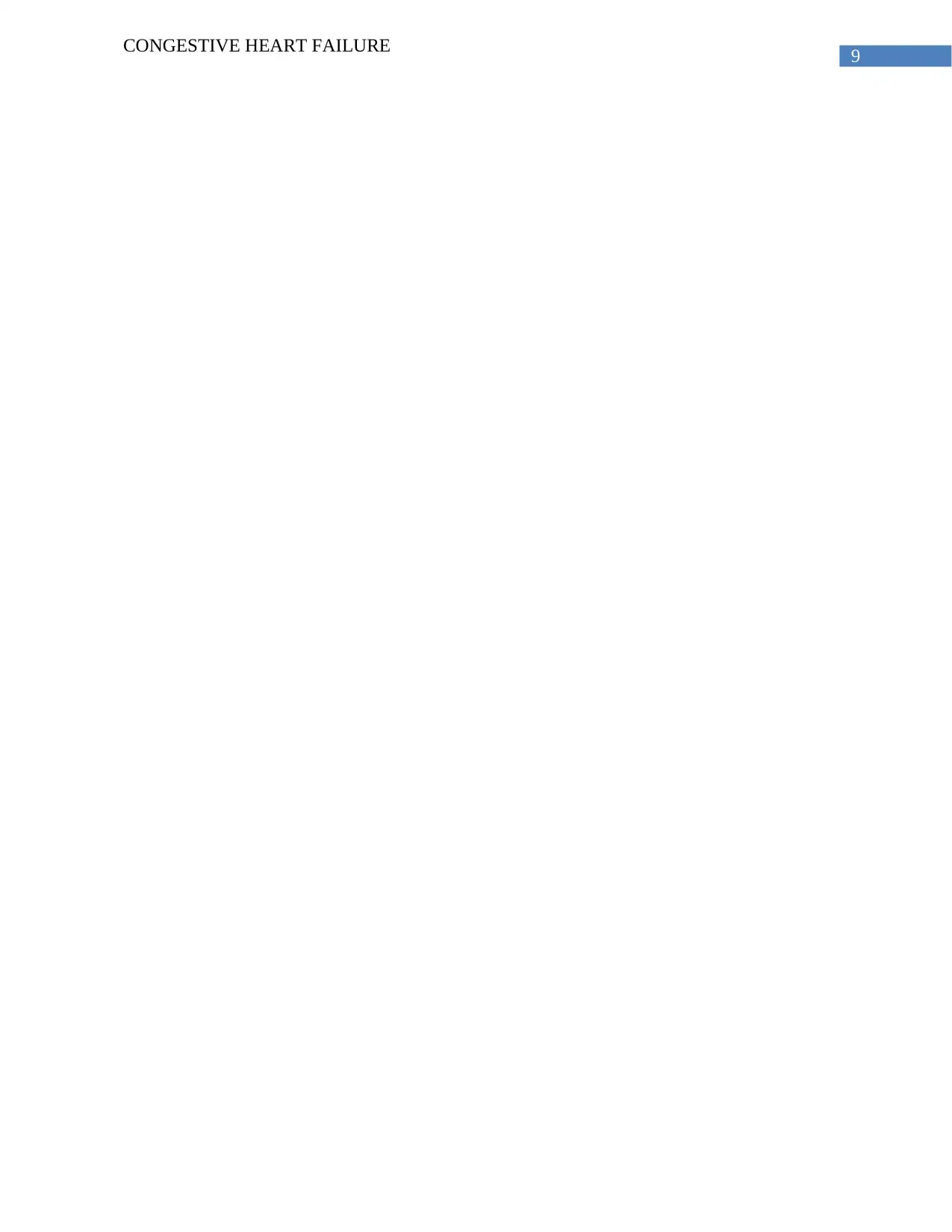
9
CONGESTIVE HEART FAILURE
CONGESTIVE HEART FAILURE
Paraphrase This Document
Need a fresh take? Get an instant paraphrase of this document with our AI Paraphraser
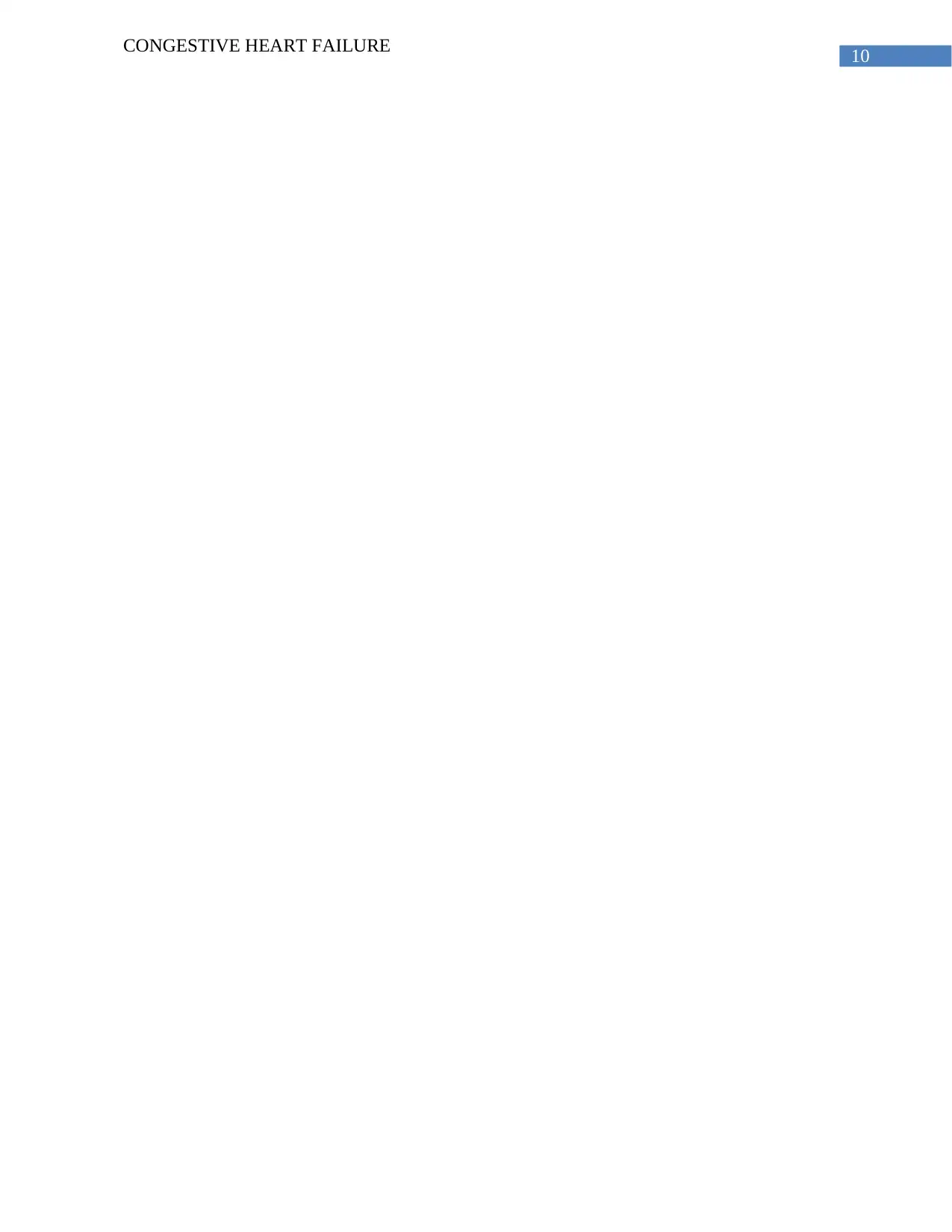
10
CONGESTIVE HEART FAILURE
CONGESTIVE HEART FAILURE
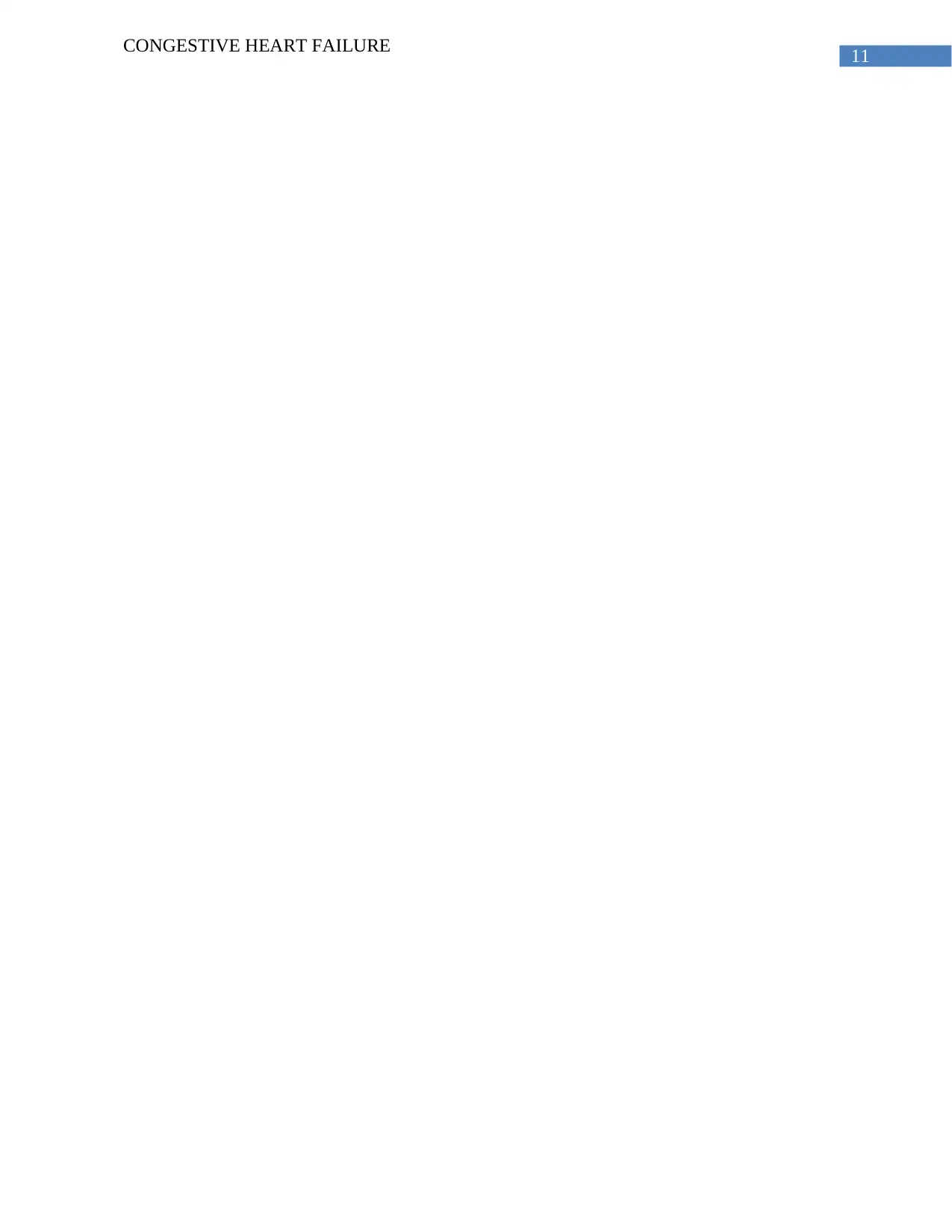
11
CONGESTIVE HEART FAILURE
CONGESTIVE HEART FAILURE
⊘ This is a preview!⊘
Do you want full access?
Subscribe today to unlock all pages.

Trusted by 1+ million students worldwide
1 out of 16
Related Documents
Your All-in-One AI-Powered Toolkit for Academic Success.
+13062052269
info@desklib.com
Available 24*7 on WhatsApp / Email
![[object Object]](/_next/static/media/star-bottom.7253800d.svg)
Unlock your academic potential
Copyright © 2020–2025 A2Z Services. All Rights Reserved. Developed and managed by ZUCOL.




